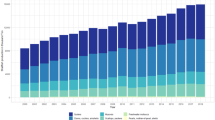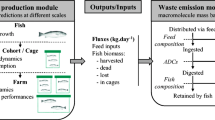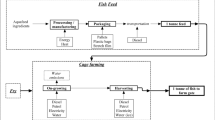Abstract
Purpose
Seafood life cycle assessment (LCA) studies have adopted the primary production required (PPR) indicator to account for the impact of these production systems (e.g., capture fisheries or aquaculture) on the ecosystems they harvest wild inputs from. However, there exists a large diversity in the application of methods to calculate PPR, and current practice often does not consider species- and ecosystem-specific factors. Here, we critically examine current practice and propose a refined method for applying the PPR metric in seafood LCAs.
Methods
We surveyed seafood LCAs that quantify PPR, or its derivatives, to examine the diversity of practice. We then defined and applied a refined method to a case study of the average Norwegian salmon feed in 2012. This refined method incorporates species-specific fishmeal and oil yields, source ecosystem-specific transfer efficiencies and expresses results as a percentage of total ecosystem production that PPR represents. Results were compared to those using previously applied methods based on the literature review, and the impact of uncertainty and natural variability of key input parameters was also assessed using Monte Carlo simulation.
Results and discussion
From the literature review, most studies do not incorporate species-specific fishmeal and oil yields or ecosystem-specific transfer efficiencies when calculating PPR. Our proposed method, which incorporated source species- and ecosystem-specific values for these parameters, provides far greater resolution of PPR than when employing global average values. When alternative methods to calculate PPR were applied to marine inputs to Norwegian salmon feeds, resulting PPR values were similar for some sources of fishmeal and oil. For other species, such as Atlantic herring from ecosystems with low transfer efficiencies, there was a large divergence in resulting PPR values. For combined inputs to Norwegian salmon feeds in 2012, the refined method resulted in a total PPR value that is three times higher than would result using the currently standard method signaling that previous LCA research may have substantially underestimated the marine biotic impacts of fishery products.
Conclusions
While there exists a great diversity of practice in the application of the PPR indicator in seafood LCA, the refined method should be adopted for future LCA studies to be more specific to the context of the study.





Similar content being viewed by others
Notes
While in total 26 studies were surveyed (Table 1), many of the items that are compared in the following sections are not applicable to all studies. Therefore, the number of studies indicated is not always in relation to all 26 studies, but relative to those studies where it was applicable.
References
Alder J, Pauly D (2006) On the multiple uses of forage fish: from ecosystem to markets. Fish Cent Res Reports 14:109
Almeida C, Vaz S, Cabral H, Ziegler F (2014) Environmental assessment of sardine (Sardina pilchardus) purse seine fishery in Portugal with LCA methodology including biological impact categories. Int J Life Cycle Assess 19:297–306. doi:10.1007/s11367-013-0646-5
Aubin J, Baruthio A, Mungkung R, Lazard J (2015) Environmental performance of brackish water polyculture system from a life cycle perspective : a Filipino case study. Aquaculture 435:217–227. doi:10.1016/j.aquaculture.2014.09.019
Aubin J, Papatryphon E, Van der Werf HMG et al (2006) Characterisation of the environmental impact of a turbot (Scophthalmus maximus) re-circulating production system using life cycle assessment. Aquaculture 261:1259–1268. doi:10.1016/j.aquaculture.2006.09.008
Aubin J, Papatryphon E, van der Werf HMG, Chatzifotis S (2009) Assessment of the environmental impact of carnivorous finfish production systems using life cycle assessment. J Clean Prod 17:354–361. doi:10.1016/j.jclepro.2008.08.008
Avadí A, Fréon P, Quispe I (2014a) Environmental assessment of Peruvian anchoveta food products: is less refined better? Int J Life Cycle Assess 19:1276–1293. doi:10.1007/s11367-014-0737-y
Avadí A, Fréon P, Tam J (2014b) Coupled ecosystem/supply chain modelling of fish products from sea to shelf: the Peruvian anchoveta case. PLoS One. doi:10.1371/journal.pone.0102057
Ayer N, Tyedmers P, Pelletier N et al (2007) LCA methodology co-product allocation in life cycle assessments of seafood production systems: review of problems and strategies. Int J Life Cycle Assess 12:480–487
Baumann M (1995) A comment on transfer efficiencies. Fish Oceanogr 4:264–266
Bishop JDK, Amaratunga GAJ, Rodriguez C (2009) Quantifying the limits of HANPP and carbon emissions which prolong total species well-being. Environ Dev Sustain 12:213–231
Boissy J, Aubin J, Drissi A et al (2011) Environmental impacts of plant-based salmonid diets at feed and farm scales. Aquaculture 321:61–70
BSI (2012) PAS 2050-2:2012 Assessment of life cycle greenhouse gas emissions
Cao L, Diana JS, Keoleian GA, Lai Q (2011) Life cycle assessment of Chinese shrimp farming systems targeted for export and domestic sales. Environ Sci Technol 45:6531–6538. doi:10.1021/es104058z
Chapin FS, Zavaleta ES, Eviner VT et al (2000) Consequences of changing biodiversity. Nature 405:234–242
Chassot E, Bonhommeau S, Dulvy NK et al (2010) Global marine primary production constrains fisheries catches. Ecol Lett 13:495–505
Chavez FP, Messié M, Pennington JT (2011) Marine primary production in relation to climate variability and change. Ann Rev Mar Sci 3:227–260
Chen X, Samson E, Tocqueville A, Aubin J (2015) Environmental assessment of trout farming in France by life cycle assessment: using bootstrapped principal component analysis to better define system classification. J Clean Prod 87:87–95. doi:10.1016/j.jclepro.2014.09.021
Coll M, Libralato S, Tudela S et al (2008) Ecosystem overfishing in the ocean. PLoS One 3:e3881
Cury PM, Boyd IL, Bonhommeau S et al (2011) Global seabird response to forage fish depletion—one-third for the birds. Science 334:1703–1706
D’Orbcastel ER, Blancheton J-P, Aubin J (2009) Towards environmentally sustainable aquaculture: comparison between two trout farming systems using life cycle assessment. Aquac Eng 40:113–119
Draganovic V, Jørgensen SE, Boom R et al (2013) Sustainability assessment of salmonid feed using energy, classical exergy and eco-exergy analysis. Ecol Indic 34:277–289
Efole Ewoukem T, Aubin J, Mikolasek O et al (2012) Environmental impacts of farms integrating aquaculture and agriculture in Cameroon. J Clean Prod 28:208–214. doi:10.1016/j.jclepro.2011.11.039
Emanuelsson A, Ziegler F, Pihl L et al (2014) Accounting for overfishing in life cycle assessment: new impact categories for biotic resource use. Int J Life Cycle Assess 19:1156–1168
FAO (1986) The products. In: Prod. fish meal oil. http://www.fao.org/docrep/003/x6899e/x6899e11.htm#10.1.2. Accessed 5 May 2014
Farmery A, Gardner C, Green BS et al (2015) Life cycle assessment of wild capture prawns: expanding sustainability considerations in the Australian northern prawn fishery. J Clean Prod 87:96–104. doi:10.1016/j.jclepro.2014.10.063
Foley JA, Defries R, Asner GP et al (2005) Global consequences of land use. Science 309:570–574
Foley JA, Monfreda C, Ramankutty N, Zaks D (2007) Our share of the planetary pie. Proc Natl Acad Sci USA 104:12585–12586
Foley JA, Ramankutty N, Brauman KA et al (2011) Solutions for a cultivated planet. Nature 478:337–342
Folke C, Kautsky N, Berg H et al (1998) The ecological footprint concept for sustainable seafood production: a review. Ecol Appl 8:63–71
Ford JS, Pelletier N, Ziegler F et al (2012) Proposed local ecological impact categories and indicators for life cycle assessment of aquaculture. J Ind Ecol 16:254–265
Froese R, Pauly D (2012) FishBase. In: World Wide Web Electron. Publ. version (04/2012). www.fishbase.org
Gmel G (2010) The good, the bad and the ugly. Addiction 105:203–205. doi:10.1111/j.1360-0443.2009.02764.x, author reply 205–206
Heymans J, Coll M, Libralato S, Christensen V (2011) Ecopath theory, modeling, and application to coastal ecosystems. Treatise on Estuarine and Coastal Science Elsevier, pp 93–113
Hognes ES, Nilsson K, Sund V, Ziegler F (2014) LCA of Norwegian salmon production 2012. SINTEF: Trondheim, Norway. Retrieved from: https://www.sintef.no/publikasjon/?pubid=SINTEF+A26401
Hornborg S, Nilsson P, Valentinsson D, Ziegler F (2012) Integrated environmental assessment of fisheries management: Swedish Nephrops trawl fisheries evaluated using a life cycle approach. Mar Policy 36:1193–1201
Hornborg S, Belgrano A, Bartolino V et al (2013a) Trophic indicators in fisheries : a call for re-evaluation Trophic indicators in fisheries : a call for re-evaluation. Biol Lett. doi: http://dx.doi.org/10.1098/rsbl.2012.1050
Hornborg S, Svensson M, Nilsson P, Ziegler F (2013b) By-catch impacts in fisheries: utilizing the IUCN Red list categories for enhanced product level assessment in seafood LCAs. Environ Manage 52:1239–1248
Hutchings J, Reynolds J (2004) Marine fish population collapses: consequences for recovery and extinction risk. Bioscience 54:297–309
ISO (2006) 14040: 2006—environmental management—life cycle assessment—Principles and Framework
Jackson A (2009) Fish in-fish out (FIFO) ratios explained
Jerbi MA, Aubin J, Garnaoui K et al (2012) Life cycle assessment (LCA) of two rearing techniques of sea bass (Dicentrarchus labrax). Aquac Eng 46:1–9
Krausmann F, Erb K-H, Gingrich S et al (2013) Global human appropriation of net primary production doubled in the 20th century. Proc Natl Acad Sci USA 110:10324–10329
Langlois J, Fréon P, Delgenes J-P et al (2014) New methods for impact assessment of biotic-resource depletion in LCA of fisheries: theory and application. J Clean Prod 73:63–71
Libralato S, Coll M, Tudela S et al. (2008) Novel index for quantification of ecosystem effects of fishing as removal of secondary production. Mar Ecol Prog Ser 355:107–129
Lindeijer E, Müller-Wenk R, Steen B (2002) Impact assessment of resources and land use. In: Haes H de, Finnveden G, Goedkoop M, et al. (eds) Life-Cycle Impact Assessment: Striving Towards Best Practice. Society of Environmental Toxicology and Chemistry (SETAC), Pensacola, FL, pp 11–64
May RM (1976) Theoretical ecology: principles and applications. Saunders, Philadelphia
McGrath KP, Pelletier NL, Tyedmers PH (2015) Life cycle assessment of a novel closed-containment salmon aquaculture technology. Environ Sci Technol 49:5628–5636
Mungkung R, Aubin J, Prihadi TH et al (2013) Life cycle assessment for environmentally sustainable aquaculture management: a case study of combined aquaculture systems for carp and tilapia. J Clean Prod 57:249–256. doi:10.1016/j.jclepro.2013.05.029
Nilsson P, Ziegler F (2007) Spatial distribution of fishing effort in relation to seafloor habitats in the Kattegat, a GIS analysis. Aquat Conserv Mar Freshw Ecosyst 440:421–440
Papatryphon E, Petit J, van der Werf HMG, Kaushik SJ (2003) Life cycle assessment of trout farming in France: a farm level approach. In: Halberg N (ed) DIAS Rep. Life Cycle Assess. Agri-food Sect, Bygholm, Denmark, pp 71–77
Papatryphon E, Petit J, Kaushik SJ, van der Werf HMG (2004) Environmental impact assessment of salmonid feeds using life cycle assessment (LCA). AMBIO A J Hum Environ 33:316–323
Parker R, Tyedmers P (2012a) Uncertainty and natural variability in the ecological footprint of fisheries: a case study of reduction fisheries for meal and oil. Ecol Indic 16:76–83
Parker R, Tyedmers P (2012b) Life cycle environmental impacts of three products derived from wild-caught Antarctic krill (Euphausia superba). Environ Sci Technol 46:4958–4965
Pauly D, Christensen V (1995) Primary production required to sustain global fisheries. Nature 374:255–257
Pauly D, Alder J, Bennett E et al (2003) The future for fisheries. Science 302:1359–1361
Pelletier N, Tyedmers P (2007) Feeding farmed salmon: is organic better? Aquaculture 272:399–416
Pelletier N, Tyedmers P (2010) Life cycle assessment of frozen tilapia fillets from Indonesian lake-based and pondbased intensive aquaculture systems. J Ind Ecol 14:467–481. doi:10.1111/j.1530-9290.2010.00244.x
Pelletier N, Tyedmers P, Sonesson U et al (2009) Not all salmon are created equal: life cycle assessment (LCA) of global salmon farming systems. Environ Sci Technol 43:8730–8736
Pelletier N, Audsley E, Brodt S et al (2011) Energy intensity of agriculture and food systems. Annu Rev Environ Resour 36:223–246
Pelletier N, Ardente F, Brandão M et al (2014) Rationales for and limitations of preferred solutions for multi-functionality problems in LCA: is increased consistency possible? Int J Life Cycle Assess 20:74–86
Pinsky ML, Jensen OP, Ricard D, Palumbi SR (2011) Unexpected patterns of fisheries collapse in the world’s oceans. Proc Natl Acad Sci 108:8317–8322
Platt T, Sathyendranath S (1988) Oceanic primary production: estimation by remote sensing at local and regional scales. Science 241:1613–1620
Rockström J, Steffen W, Noone K et al (2009) Planetary boundaries: exploring the safe operating space for humanity. Ecol Soc 14:32
Ryther JH (1969) Photosynthesis and fish production in the sea. Science 166:72–76
Sauvant D, Perez JM, Tran G (2004) Tables of composition and nutritional value of primary materials destined for stock animals: pigs, poultry, cattle, sheep, goats, rabbits, horses, fish, 2nd edn. Tables Compos Val Nutr des matieres premieres Destin aux animaux d’elage Porc volailles, Bov ovins, caprins, lapins, chevaux, Poisson. doi: 10.3920/978-90-8686-668-7
Sea Around Us Project (2014) Large marine ecosystems (LME)—Sea Around Us Project. http://www.seaaroundus.org/lme/. Accessed 18 Feb 2014
Shepherd CJ, Jackson A (2013) Global fishmeal and fish-oil supply: inputs, outputs and markets. J Fish Biol 83:1046–1066
Slobodkin LB (1962) Energy in animal ecology. Adv Ecol Res 1:69–101. doi:10.1016/S0065-2504(08)60301-3
Smith ADM, Brown CJ, Bulman CM et al (2011) Impacts of fishing low-trophic level species on marine ecosystems. Science 333:1147–1150
Swartz W, Sala E, Tracey S et al (2010) The spatial expansion and ecological footprint of fisheries (1950 to present). PLoS One 5:e15143
Tacon AGJ, Metian M (2008) Global overview on the use of fish meal and fish oil in industrially compounded aquafeeds: trends and future prospects. Aquaculture 285:146–158
Troell M, Tyedmers P, Kautsky N, Rönnbäck P (2004) Aquaculture and energy use. Encycl Energy 2:97–108
Troell M, Naylor RL, Metian M et al (2014) Does aquaculture add resilience to the global food system? Proc Natl Acad Sci 111:13257–13263
Tyedmers P (2001) Energy consumed by North Atlantic fisheries. Fisheries Impacts on North Atlantic Ecosystems: Catch, Effort, and National/Regional Data Sets. Fisheries Centre, University of British Columbia: Vancouver, British Columbia, pp 12–34
Vázquez-Rowe I, Moreira MT, Feijoo G (2012) Inclusion of discard assessment indicators in fisheries life cycle assessment studies. Expanding the use of fishery-specific impact categories. Int J Life Cycle Assess 17:535–549
Vázquez-Rowe I, Villanueva-Rey P, Hospido A et al (2014) Life cycle assessment of European pilchard (Sardina pilchardus) consumption. A case study for Galicia (NW Spain). Sci Total Environ 475C:48–60
Vitousek P, Ehrlich P, Ehrlich A, Matson P (1986) Human appropriation of the products of photosynthesis. Bioscience 36:368–373
Wackernagel M, Rees W (1996) Our ecological footprint: reducing human impact on the Earth. Our Ecol Footpr. doi:10.1162/jiec.1999.3.2-3.185
Watson R, Zeller D, Pauly D (2014) Primary productivity demands of global fishing fleets. Fish Fish 15:231–241
Weidema BP, Schmidt JH (2010) Avoiding allocation in life cycle assessment revisited. J Ind Ecol 14:192–195
Weinzettel J (2012) Understanding who is responsible for pollution: what only the market can tell us—comment on “an ecological economic critique of the use of market Information in life cycle assessment research.”. J Ind Ecol 16:455–456
Welch A, Hoenig R, Stieglitz J et al (2010) From fishing to sustainable farming of carnivorous marine finfish. Rev Fish Sci 18:235–247
Wilfart A, Prudhomme J, Blancheton J-P, Aubin J (2013) LCA and emergy accounting of aquaculture systems: towards ecological intensification. J Environ Manage 121:96–109
Worm B, Barbier EB, Beaumont N et al (2006) Impacts of biodiversity loss on ocean ecosystem services. Science 314:787–790
Worm B, Hilborn R, Baum JK et al (2009) Rebuilding global fisheries. Science 325:578–585
Ytrestøyl T, Aas TST, Berge GGM, et al (2011) Resource utilisation and eco-efficiency of Norwegian salmon farming in 2010. SINTEF: Tromso, Norway. Retrieved from: http://www.nofima.no/filearchive/rapport-53-2011_5.pdf
Author information
Authors and Affiliations
Corresponding author
Additional information
Responsible editor: Ian Vázquez-Rowe
Rights and permissions
About this article
Cite this article
Cashion, T., Hornborg, S., Ziegler, F. et al. Review and advancement of the marine biotic resource use metric in seafood LCAs: a case study of Norwegian salmon feed. Int J Life Cycle Assess 21, 1106–1120 (2016). https://doi.org/10.1007/s11367-016-1092-y
Received:
Accepted:
Published:
Issue Date:
DOI: https://doi.org/10.1007/s11367-016-1092-y




